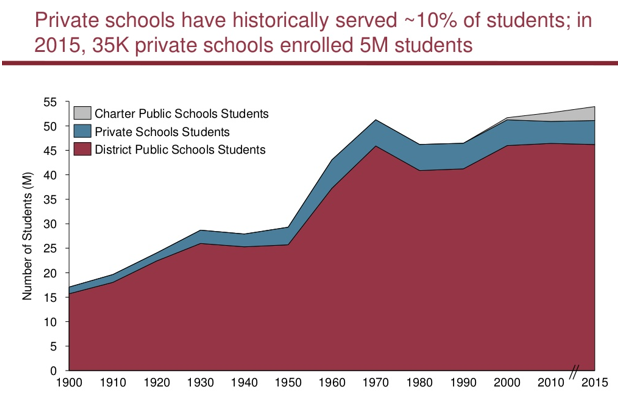 Bellwether Education researchers recently released an interesting slide deck that shows how private schools and microschools seek to serve middle- and low-income students. Slide 10 is especially interesting, illustrating trends in American school enrollment – district, private and charter – since 1900.
Bellwether Education researchers recently released an interesting slide deck that shows how private schools and microschools seek to serve middle- and low-income students. Slide 10 is especially interesting, illustrating trends in American school enrollment – district, private and charter – since 1900.

A deeper dive
If you are attempting to read this on your phone, charter schools are indicated by the small grey area at the top right. That grey smidge is what passes for “the destruction of public education” in certain hyperbolic circles, by the way.
The Bellwether chart should, in fact, make charter advocates feel daunted rather than encourage charter opponents to make elaborate claims that the sky is falling. But charter supporters should not despair.
Choice programs can leverage changes bigger than the charter sector alone. With some adjustments to strategy, determined effort and patience, opportunity hawks can transform a growing portion of the red in the chart to a choice system.
Meanwhile, in Florida …
According to Florida Department of Education figures, 47 percent of the state’s 3.4 million preK-12 students attended a school of their choice during the 2017-18 school year. While district options always have involved a good deal of choice for those with the purchasing power to strategically buy into neighborhoods with high-performing schools, policy changes in recent years have encouraged cross-district transfers.
What’s interesting is that the state reports that the second- and third-largest sources of Florida choice (open enrollment and choice/magnet programs, with 262,633 and 226,122 students, respectively) both exceeded the number of families paying private school tuition out of their own funds (225,033 students).
In fact, these two sources of publicly provided choice together exceed the combined enrollment of family-financed private school choice, all of Florida’s private choice programs and home-schooling combined.
Florida K-12 choice is not being done to districts, but by districts.
And what’s more …
In addition to their direct contribution in educating 292,001 Florida students, Florida’s charter schools help create the incentive for Florida districts to permit and seek open enrollment transfers. This trend encourages specialization in schooling, which allows families more meaningful choices in seeking a strong school and good fit for their child.
American school districts are filled with people who went into education for the right reasons. They all too often find themselves thwarted in their efforts by their own organizational malaise. Innovations like charter schools, and more recently micro-schools, provide educators the opportunity to create their own schools, to be masters of their own destiny, and to sink or swim based upon the freely chosen decisions of families.
The bottom line
The Bellwether chart certainly shows the need for greater choice. This conclusion from Education Next senior editor Paul Peterson seems just as valid today as when he wrote it three years ago:
“If the future of charter schools remains uncertain, the same cannot be said for top-down regulation. Unless teachers surprise us all by embracing a new curriculum generated by Common Core standards, and that curriculum motivates students to make a greater commitment to their learning, reforming the system from within is unlikely to succeed in the years ahead.
“If school reform is to move forward, it will occur via new forms of competition, whether they be vouchers, charters, homeschooling, digital learning, or the transformation of district schools into decentralized autonomous units. And if student testing has an impact on reform, it will be due to the better information parents receive about the amount of learning taking place at each school. The Bush-Obama era of reform via federal regulation has come to an end.”


